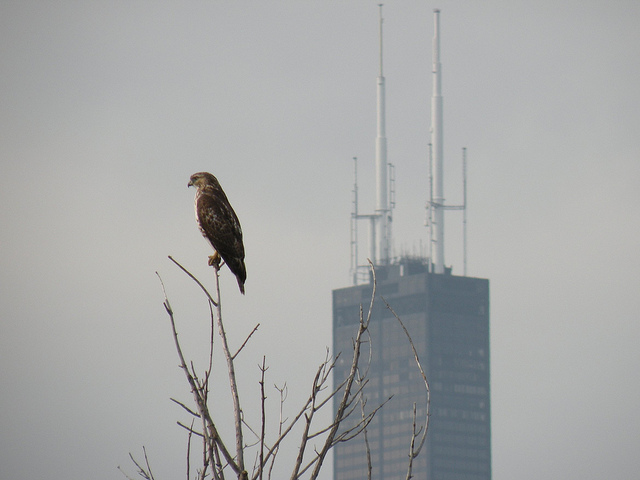
Pip, the recently hatched red-tailed hawk featured in the New York Times “hawk cam,” was only the latest in a string of successful raptor hatchings in big cities. On the surface, raptors appear to have adapted to city living marvelously. Tall buildings present ideal perches and nesting sites, and lackadaisical pigeons provide easy meals. But as is often the case in ecology, the real story of urban raptors is far more complicated than can be shown with a simple web cam.
For all their visible successes, raptors still face myriad dangers in the city. Chief among them are windows. Anyone who has jumped at the sudden thud of a bird flying into a window—it happened to me yesterday in my office, so the sound is fresh in my mind—knows just how hard they hit. Nearly 25 percent of North American bird species are known to routinely smack into windows, and every building on the continent is thought to cause between one and ten deaths per year. Birds of prey are no exception. In fact, famed naturalist Thomas Nuttall recorded the first such strike in 1832, which involved a sharp-shinned hawk caroming into a window. A later study in Tucson, Arizona, reported that the majority of adult Cooper’s hawk fatalities were caused by collisions with windows.
But panes of glass are not the only dangers raptors face. Just making it out of the nest is an enormous milestone which, depending on the city, could be a 50-50 proposition. The Tucson survey reported that just less than half of all urban-born nestlings survived two weeks beyond their first flight, compared with over 95 percent in the surrounding countryside. Though their parents nested earlier and at higher densities and laid larger clutches than birds from the countryside, the nestlings devastatingly low survival rate meant fewer city hawks made it to adulthood. An overwhelming number fatalities were caused by a strain of the protozoan trichomoniasis, which is found in pigeons and doves and may be spread by tainted bird feed. Such birds constituted a large majority of urban Cooper’s hawks’ diet, but a small portion for country hawks.
The Tucson case isn’t unique, but neither is it universal. Other studies have investigated the trichomoniasis-urban hawk link and have come up empty handed, leading scientists to believe the problem is dependent on both the species and health of the doves on which the hawks feed. Still, it brings to light another concern that ecologists have about cities. For many birds—raptors included—cities may be “ecological traps.” Those environmental signals I mentioned above—preferable perches, natty nesting sites, and easy eats—may lure birds to cities, but environmental hazards such as windows, diseases, and vengeful humans can erode overall population numbers. Ecologists call this a population sink.
The solution isn’t easy or straightforward, especially for raptors. In the case of trichomoniasis, treating adults is possible in the early stages, but laborious. Nestlings can also be treated, but run the risk of reinfection when returned to the nest. Window strikes are even more troublesome—the usual window silhouettes do little to repel raptors, probably because they are modeled after those very same birds. Another option is to move bird feeders away from windows, since they attract prey species like doves, but that solution defeats the purpose of bird feeders for many people. Rather, limiting human impacts appears to be the real solution. Raptors are most successful is in areas of little human disturbance. While raptors do best in unspoiled native habitat, they can also thrive in low density residential areas. Chalk one up for small towns and suburbia.
Sources:
Boal, C., & Mannan, R. (1999). Comparative Breeding Ecology of Cooper’s Hawks in Urban and Exurban Areas of Southeastern Arizona The Journal of Wildlife Management, 63 (1) DOI: 10.2307/3802488
Chace, J., & Walsh, J. (2006). Urban effects on native avifauna: a review Landscape and Urban Planning, 74 (1), 46-69 DOI: 10.1016/j.landurbplan.2004.08.007
Dunn, Erica H. (1993). Bird Mortality from Striking Residential Windows in Winter Journal of Field Ornithology, 64 (3), 302-309
Klem, Jr., Daniel. (1989). Bird-Window Collisions The Wilson Bulletin, 101 (4), 606-620
Photo by Chicago Man.